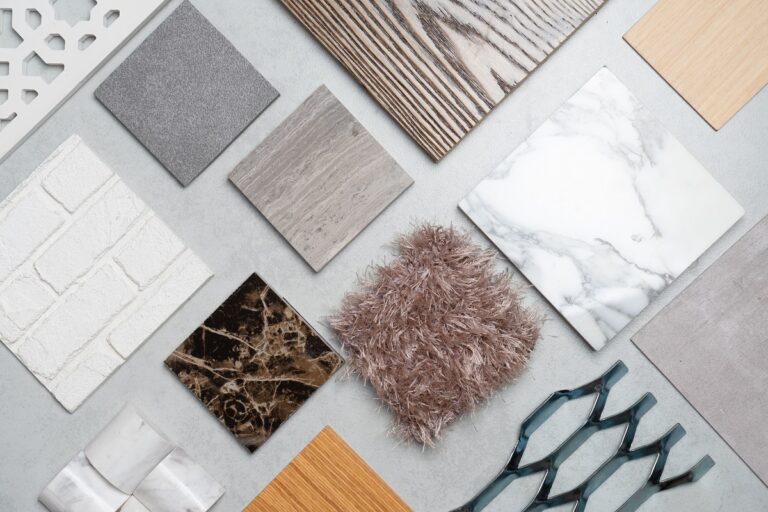As an interior designer, your designs are only as good as the team that brings them to life. That’s why building strong collaborative relationships with contractors is essential to success in this industry. Yet, navigating those relationships—and the complexities of construction—can be one of the most challenging parts of the job. The more aligned you are with your contractor from the beginning, the smoother every phase of the project will be—from initial demolition to final styling. A thoughtful approach to collaboration not only protects your design but also elevates your client’s experience.
In this post, we’ll explore how to work seamlessly with contractors and share practical tips to keep your projects running smoothly, on time, and on budget.
Table of Contents
5 main ways interior designers work with contractors
While interior designers and contractors have distinct roles, they both follow similar phases of a project. As you work through your project management process, look for opportunities to incorporate the following contractor collaborations to streamline and optimize your workflow:
#1: Plan the project together
Before construction begins, designers and contractors may come together to define the project scope, schedule, and budget. The interior designer contributes the overall vision for how the space should look, feel, and function. Meanwhile, the contractor provides practical input on pricing, what is structurally possible, how long various tasks will take, and what materials or methods make the most sense from a building standpoint.
As a designer meeting with a contractor in the planning phase, you can expect to discuss:
- Timelines for design work, permits, and construction
- Budget targets and allowances
- Key deliverables and communication expectations
- Division of responsibilities between the trades and design teams
This meeting sets the stage for the entire project and should be a consistent part of your interior design process checklist whenever working with a contractor.
#2: Review drawings and specs
As the design phase progresses, interior designers produce detailed drawings and specification documents. These may include:
- Floor plans and elevations
- Reflected ceiling plans
- Furniture layouts and lighting plans
- Material and finish schedules
- 3D visualizations or renderings
Contractors review these documents to assess feasibility. They check for code compliance, material availability, and any structural limitations.
Designers and contractors often engage in a back-and-forth dialogue throughout this stage to refine details, make adjustments as necessary, and resolve any inconsistencies before construction begins. This helps ensure the vision is executed safely and accurately, without surprises that could derail the project later.
#3: Collaborate on-site
Construction is dynamic, and real-world conditions often don’t align with the plans. That’s why designers often visit the site during the build. These visits help:
- Ensure the correct implementation of the design
- Verify placement of fixtures, lighting, and finishes
- Catch errors before they become costly
- Make real-time decisions when issues arise
These in-person visits also strengthen communication between designers, contractors, and tradespeople, reducing delays and minimizing miscommunication.
#4: Solve problems together
Even with detailed plans, surprises happen: hidden plumbing issues, discontinued materials, or structural discoveries.
When inevitable issues arise, designers and contractors should work together to find practical solutions that preserve the design intent. This may include:
- Selecting alternative materials
- Adjusting layouts slightly
- Revising timelines or budgets
When changes affect cost or scope, a change order should be issued to ensure all parties (including the client) are aligned.
#5: Final walkthrough and quality check
As the project wraps up, designers and contractors typically perform a final walkthrough together to assess the completed work. This review ensures the space reflects the design intent and meets quality standards. Tasks might include:
- Verifying that paint, finishes, and materials are correctly applied
- Ensuring lighting, fixtures, and furniture are properly installed
- Testing systems and appliances, if applicable
Any remaining issues are added to a punch list, which is a formal list of items that need to be corrected before project closeout. These could be small fixes like touch-up paint or larger adjustments like moving a light fixture.
How to prevent issues when working with contractors
Communication issues are among the most common pitfalls when working with contractors. Misunderstandings or a lack of clarity can lead to delays, cost overruns, and client dissatisfaction. The key to avoiding this is clear documentation.
Start with a Spec Book
A Spec Book is one of the most powerful tools you can use to streamline communication and avoid missteps. A Spec Book is a detailed, organized document that outlines every aspect of your design, helping contractors understand your vision and execute it as intended. Here are some key details it should include:
- Material selections
- Furniture layouts and placement
- Product names and sourcing info
- Detailed dimensions
- Installation instructions and tips
Why a Spec Book Works
A Spec Book serves as your go-to reference for every contractor and tradesman involved in the project. By consolidating all the information in a single, organized document, it minimizes the risk of confusion and reduces the need for frequent clarifications. It also allows contractors to:
- Cross-reference materials and dimensions independently to reduce the need for frequent questions.
- Stay aligned with the design vision even if there are last-minute changes or adjustments.
- Ensure all parties (trades, suppliers, installers) are on the same page regarding expectations.
Interested in learning how to build a powerful Spec Book? Explore Emily Yeates’ tried-and-true method through a DesignFiles video workshop or written Spec Book guide—both of which are available now.
More ways to work more efficiently with contractors
Spec books are incredible tools for ensuring your design vision is executed properly, but effective collaboration goes beyond just providing documentation. Use these actionable tips to improve communication and build positive working relationships during your next collaborative project:
Understand the contractor’s workflow:
- Ask about their preferred communication style (text, email, job site meetings, etc.).
- Clarify how often they’d like to receive updates or approvals.
- Learn how they schedule subs and manage their teams—this will help you better time your deliverables.
- If they use project management software, ask to be added as a team member.
Explain the why, not just the what:
- Provide context for design decisions (such as “This tile pattern aligns with the sightline from the entry.”).
- Be open to alternative methods that achieve the same design result, especially when problems arise.
Clearly define priorities and deal-breakers:
- Highlight your non-negotiable design elements upfront.
- Identify areas where substitutions or layout changes are acceptable.
- Share this list with both the contractor and any key tradesmen during early meetings.
Provide prompt, constructive feedback:
- Don’t wait—bring up issues as soon as you spot them.
- Avoid blame—frame feedback around solutions (“How can we adjust this to better match the plan?”).
- Always document agreed-upon fixes in writing or your shared task tracker.
- Follow up to confirm the issue was resolved correctly.
Use physical mock-ups and site samples:
- Request a sample installation for complex tile patterns, lighting alignments, or custom millwork.
- Approve grout colors, hardware finishes, or paint swatches on-site under real lighting.
- Snap photos of the mock-up and include notes in your site report or punch list.
Frequently asked questions about working with contractors
It depends on the project. Sometimes the client hires both parties separately; other times, the designer may recommend or coordinate with a preferred contractor. Either way, both parties typically work under the client’s direction unless the designer is acting as the project manager.
Designers can charge clients with a flat fee, an hourly rate, a percentage of the project cost, or a cost-plus markup on contractor services. It’s essential to clarify the pricing structure upfront to ensure transparency and avoid confusion.
The contractor usually takes the lead in addressing construction-related problems, but the designer is often involved in finding solutions—especially if the issue impacts design choices or layout. Collaboration is key to resolving problems efficiently.
Be dependable, respectful, and solution-oriented. Share credit when things go well and address problems constructively. A strong, mutually respectful relationship increases the chances of being recommended to future clients and being included on more projects.
Ask for a post-project debrief. After a job wraps, check in with the contractor to discuss what went well and what could be improved. It builds mutual respect, helps refine your process, and shows that you’re invested in long-term professional growth, not just one-off success.
Want your design projects to run smoother than ever? Start your free trial of DesignFiles, no credit card required.


